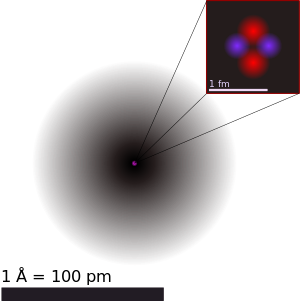Our website is made possible by displaying online advertisements to our visitors.
Please consider supporting us by disabling your ad blocker.
Atomic nucleus
This article includes a list of references or other websites, but its sources remain unclear because it does not have enough inline citations. (June 2008) |

The nucleus is the center of an atom. It is made up of nucleons called protons and neutrons and is surrounded by the electron cloud. The size (diameter) of the nucleus is between 1.6 fm (10−15 m) (for a proton in light-weight hydrogen) to about 15 fm (for the heaviest atoms, such as uranium). These sizes are much smaller than the size of the atom itself by a factor of about 23,000 (uranium) to about 145,000 (hydrogen). Although it is only a very small part of the atom, the nucleus has most of the mass. Almost all of the mass in an atom is made up from the protons and neutrons in the nucleus. Only a small amount of mass is from the orbiting electrons.
Neutrons have no electric charge and protons are positively charged. Because the nucleus is only made up of protons and neutrons it is positively charged. Things that have the same charge repel each other: this repulsion is part of what is called electromagnetic force. Unless there was something else holding the nucleus together it could not exist because the protons would push away from each other. The nucleus is actually held together by another force known as the strong nuclear force.
The word nucleus is from 1704, meaning “kernel of a nut”. In 1844, Michael Faraday used nucleus to describe the “central point of an atom”. The modern atomic meaning was proposed by Ernest Rutherford in 1912.[1] The use of the word nucleus in atomic theory, however, did not happen immediately. In 1916, for example, Gilbert N. Lewis wrote in his famous article The Atom and the Molecule that "the atom is composed of the kernel and an outer atom or shell".[2]
- ↑ Nucleus – Online Etymology Dictionary
- ↑ Gilbert N. Lewis The Atom and the Molecule Archived 2007-09-18 at the Wayback Machine
Previous Page Next Page


